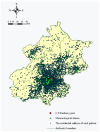Relationship between Air Pollutant Exposure and Gynecologic Cancer Risk
- PMID: 34069801
- PMCID: PMC8157305
- DOI: 10.3390/ijerph18105353
Relationship between Air Pollutant Exposure and Gynecologic Cancer Risk
Abstract
Exposure to air pollution has been suggested to be associated with an increased risk of women's health disorders. However, it remains unknown to what extent changes in ambient air pollution affect gynecological cancer. In our case-control study, the logistic regression model was combined with the restricted cubic spline to examine the association of short-term exposure to air pollution with gynecological cancer events using the clinical data of 35,989 women in Beijing from December 2008 to December 2017. We assessed the women's exposure to air pollutants using the monitor located nearest to each woman's residence and working places, adjusting for age, occupation, ambient temperature, and ambient humidity. The adjusted odds ratios (ORs) were examined to evaluate gynecologic cancer risk in six time windows (Phase 1-Phase 6) of women's exposure to air pollutants (PM2.5, CO, O3, and SO2) and the highest ORs were found in Phase 4 (240 days). Then, the higher adjusted ORs were found associated with the increased concentrations of each pollutant (PM2.5, CO, O3, and SO2) in Phase 4. For instance, the adjusted OR of gynecological cancer risk for a 1.0-mg m-3 increase in CO exposures was 1.010 (95% CI: 0.881-1.139) below 0.8 mg m-3, 1.032 (95% CI: 0.871-1.194) at 0.8-1.0 mg m-3, 1.059 (95% CI: 0.973-1.145) at 1.0-1.4 mg m-3, and 1.120 (95% CI: 0.993-1.246) above 1.4 mg m-3. The ORs calculated in different air pollution levels accessed us to identify the nonlinear association between women's exposure to air pollutants (PM2.5, CO, O3, and SO2) and the gynecological cancer risk. This study supports that the gynecologic risks associated with air pollution should be considered in improved public health preventive measures and policymaking to minimize the dangerous effects of air pollution.
Keywords: air pollutant exposure; association; gynecologic cancer risk.
Conflict of interest statement
The authors declare no conflict of interest. The funders had no role in the design of the study; in the collection, analyses, or interpretation of data; in the writing of the manuscript, or in the decision to publish the results.
Figures





Similar articles
-
Mortality-Air Pollution Associations in Low Exposure Environments (MAPLE): Phase 2.Res Rep Health Eff Inst. 2022 Jul;2022(212):1-91. Res Rep Health Eff Inst. 2022. PMID: 36224709 Free PMC article.
-
Mortality and Morbidity Effects of Long-Term Exposure to Low-Level PM2.5, BC, NO2, and O3: An Analysis of European Cohorts in the ELAPSE Project.Res Rep Health Eff Inst. 2021 Sep;2021(208):1-127. Res Rep Health Eff Inst. 2021. PMID: 36106702 Free PMC article.
-
Effects of short-term exposure to air pollution on hospital admissions of young children for acute lower respiratory infections in Ho Chi Minh City, Vietnam.Res Rep Health Eff Inst. 2012 Jun;(169):5-72; discussion 73-83. Res Rep Health Eff Inst. 2012. PMID: 22849236
-
Association between exposure to ambient air pollution and hospital admission, incidence, and mortality of stroke: an updated systematic review and meta-analysis of more than 23 million participants.Environ Health Prev Med. 2021 Jan 26;26(1):15. doi: 10.1186/s12199-021-00937-1. Environ Health Prev Med. 2021. PMID: 33499804 Free PMC article.
-
A comprehensive evaluation of the association between ambient air pollution and adverse health outcomes of major organ systems: a systematic review with a worldwide approach.Environ Sci Pollut Res Int. 2019 May;26(13):12648-12661. doi: 10.1007/s11356-019-04874-z. Epub 2019 Mar 22. Environ Sci Pollut Res Int. 2019. PMID: 30903465
Cited by
-
Environment and gynaecologic cancers.Oncol Rev. 2024 Oct 8;18:1430532. doi: 10.3389/or.2024.1430532. eCollection 2024. Oncol Rev. 2024. PMID: 39440071 Free PMC article. Review.
-
Outdoor air pollution exposure and uterine cancer incidence in the Sister Study.J Natl Cancer Inst. 2024 Jun 7;116(6):948-956. doi: 10.1093/jnci/djae031. J Natl Cancer Inst. 2024. PMID: 38346713 Free PMC article.
-
Causal impact of air pollution on head and neck cancer: a Mendelian randomization study.Discov Oncol. 2025 Jul 9;16(1):1290. doi: 10.1007/s12672-025-03139-1. Discov Oncol. 2025. PMID: 40632167 Free PMC article.
-
Air quality and cancer risk in the All of Us Research Program.Cancer Causes Control. 2024 May;35(5):749-760. doi: 10.1007/s10552-023-01823-7. Epub 2023 Dec 25. Cancer Causes Control. 2024. PMID: 38145439 Free PMC article.
-
Short-term effect of ambient air pollution on outpatient visits for children in Guangzhou, China.Front Public Health. 2023 Jan 20;11:1058368. doi: 10.3389/fpubh.2023.1058368. eCollection 2023. Front Public Health. 2023. PMID: 36741946 Free PMC article.
References
-
- Zhang L., Liu W., Hou K., Lin J., Zhou C., Tong X., Wang Z., Wang Y., Jiang Y., Wang Z., et al. Air Pollution-Induced Missed Abortion Risk for Pregnancies. Nat. Sustain. 2019;2:1011–1017. doi: 10.1038/s41893-019-0387-y. - DOI
Publication types
MeSH terms
Substances
LinkOut - more resources
Full Text Sources
Medical

